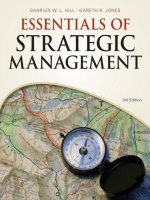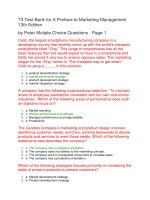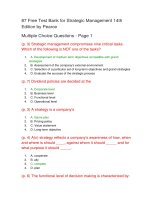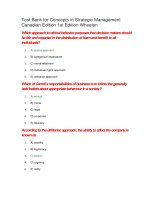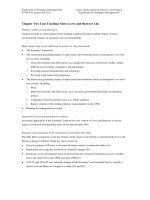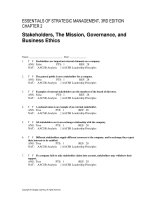Fred r david – strategic management, 13th edition ch04
Bạn đang xem bản rút gọn của tài liệu. Xem và tải ngay bản đầy đủ của tài liệu tại đây (210.24 KB, 327 trang )
Exam
Name___________________________________
TRUE/FALSE. Write 'T' if the statement is true and 'F' if the statement is false.
1)
Some companies are equally strong (or weak) in all areas of thier business.
1)
_______
2)
Objectives and strategies are established with the intention of capitalizing upon external strengths and
minimizing weaknesses.
2)
_______
3)
The internal analysis is critically important in the Arab world as upbringing and socialization may induce
executives to overestimate strengths and weaknesses.
3)
_______
4)
Within large organizations, each division has certain strengths and weaknesses.
4)
_______
5)
Opportunities are a firm's distinctive competencies that cannot be easily matched or imitated by
competitors.
5)
_______
6)
Building competitive advantages involves taking advantage of distinctive competencies.
6)
_______
7)
Few successful corporations give considerable attention to both external and internal analysis.
7)
_______
8)
Generally in the Arab world, the internal capacity to assess external environments and explore their trends
is lacking.
8)
_______
9)
Senior Arab executives should give priority to internal capacity-building processes and encourage creative
rethinking of strategic initiatives and external trends.
9)
_______
10)
The process of performing an internal assessment, compared to the external assessment, provides more
opportunity for participants to understand how their jobs, departments and divisions fit into the whole
organization.
10)
______
11)
Unlike the external assessment, the internal assessment does not require gathering and assimilating
information about the firm's functional areas.
11)
______
12)
Compared to the external analysis, the process of performing an internal analysis provides more
opportunity for participants to understand how their jobs, departments, and divisions fit into the whole
organization.
12)
______
13)
An internal audit task force of managers could be charged with determining a specific number (usually 10
to 20) of the most important strengths and weaknesses.
13)
______
MULTIPLE CHOICE. Choose the one alternative that best completes the statement or answers
the question.
14)
Performing an internal assessment requires
14)
______
A)
gathering, assimilating, and evaluating information about a firm's operations.
B)
simply focusing on the operational issues of a firm
C)
inheriting the historical data about a firm's operations.
D)
gathering, record-keeping, and safe-guarding information about a firm's operations.
TRUE/FALSE. Write 'T' if the statement is true and 'F' if the statement is false.
15)
As long as the strategic-management process is overseen by strategists, there is no need for managers
and employees from different functional areas to work together to provide ideas or information.
15)
______
16)
Not recognizing and understanding the relationships among functional areas of business can be beneficial
to strategic management.
16)
______
17)
Government and nonprofit enterprises have traditionally placed much emphasis on relationships among
the business functions.
17)
______
18)
For strategies to succeed, a coordinated effort among all the functional areas of business is needed.
18)
______
19)
Proponents of the resource-based view argue that external factors are more important than internal factors
for a firm in achieving and sustaining competitive advantage.
19)
______
20)
The basic premise of the research-based view is that the mix, type, amount and nature of a firm's internal
resources should be considered first and foremost in devising strategies that can lead to sustainable
competitive advantage.
20)
______
21)
